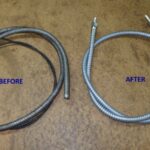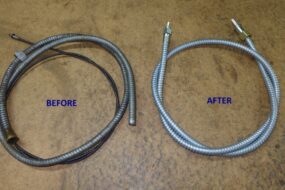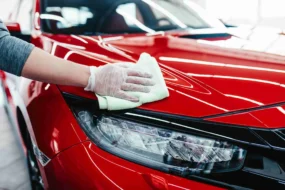In this way, each constituent in the vapour meets a tray on which it condenses out. The result is a series of separated constituents, called
fractions, which can be drawn off from the column through pipes.
There are six main fractions. The lightest, which is still a gas when it reaches the top of the column, is called refinery gas and is used as a fuel by
The rest is further processed in an additional plant. The lightest of the resulting liquid fractions are very volatile and are used for blending into
Then come naphtha (used for further processing into petrochemicals or alternatively for blending into petrol), kerosene (which is basically paraffin), diesel oils and light and heavy oils used for industrial lubricating, and then the heaviest fraction, bitumen, which is left as a
The basic fractional distillation process divides up crude oil into its pure chemical hydrocarbons. But some of these hydrocarbons are more valuable than others. In particular, the demand for petrol is much greater than for bitumen, or indeed for diesel. So some of the heavier fractions are converted at the oil
refinery into petrol. This is done by a process called cracking.
Thermal cracking uses heat in the process, while catalytic cracking uses a
chemical catalyst.
In thermal cracking the hydrocarbons are heated to between 450°C and 540°C at high pressure. The result is a low-grade fuel which is then refined again at higher temperatures and pressures to produce petrol of good enough quality to
Catalytic cracking is more useful than thermal cracking since it gives a higher yield of useful products. By adding a catalyst (usually an aluminium-silica powder) to the oil during the pre-heating phase, the heavy fractions can be broken into a mixture of lighter ones, which are then fed into
a fractionating column to be separated out.
These light fractions then undergo further processes called conversion
processes to produce the correct mix of hydrocarbons.
These conversions are followed by treatment stages where the appropriate additives are introduced to make the blended petrol suitable for winter or
summer use.
To be useful for running internal combustion engines, petrol must have certain properties. It must burn smoothly in the engine over a wide range of speeds and power outputs without detonation. This manifests itself by
‘knocking’ and, if allowed to persist, can result in serious engine damage.
The petrol must have some readily volatile constituents which allow the engine to start easily in cold weather. But the petrol must not be so volatile that it vaporizes too easily and causes a lock in the fuel system, or even
carburettor icing (see sideline, right).
The performance of petrol is gauged primarily by its octane number. To work this out, the petrol is compared with two standard fuels of known performance called n-heptane and iso-octane, both of which are hydrocarbons. N-heptane is a poor fuel for internal combustion engines and causes heavy knocking; it has an octane number of 0. Isooctane is the opposite, a very high quality fuel, and
has an octane number of 100.
If petrol has an octane number of 90 this means that it gives a performance equivalent to a mixture of 90 parts iso-octane to 10 parts nheptane. Most car
engines require petrol with an octane rating of between 90 and 100.
As a further anti-knock measure, it is still normal practice to add a small quantity of tetraethyl or tetra-methyl lead to the petrol. However, this is
steadily being curtailed because of the poisonous nature of lead.
The maximum amount of lead allowed in petrol was lowered from 0.4 to 0.15 grammes per litre in 1986, and unleaded petrol is starting to appear on the
European market. This is petrol to which no lead compounds have been added.
Fuel volatility
The volatility of a fuel —the proportion of it that evaporates at a
particular temperature — has to meet certain limits.
If the volatility is too low, the car engine is difficult to start and takes a long time to warm up. If it is too high, the engine may stall or run unevenly in hot weather because the fuel tends to vaporize before it
reaches the carburettor.
In extreme cases a volatile fuel can cause carburettor icing because, as the fuel evaporates, it absorbs heat from its surroundings, cooling the carburettor body so much that the water in the air freezes and blocks the
jets.
Diesel fuel
Diesel fuel is more viscous and heavier than petrol, is less volatile and
comes off the fractionating column at a lower level.
Diesel fuel is not graded by octane rating like petrol; instead it is given a cetane rating. This is derived by comparing diesel with two other
hydrocarbons, cetane and alpha-methylnaphthalene.
High-quality diesel fuel used in road-going vehicles has a cetane rating of about 50, while slower engines such as those used in large ships may run on fuel with a lower cetane rating. The higher the cetane rating, the easier the starting, the smoother the combustion and the lower the level of ‘diesel
knock‘.
Some low-grade diesel (called gas oil) used for stationary or off-road work is dyed for identification and is thus known as red diesel. Only white diesel,
which has had Road Tax Duty paid on it, can legally be used on the road.
Diesel fuel, like petrol, normally has important additives. Anti-freezing and anti-waxing agents have to be added to diesel fuel used in cold weather to
stop it clogging in fuel lines and injectors.
Storage/transport
From the oil refinery, the petrol and diesel are transported to their garage
and service station outlets by road or rail in specially designed tankers.
The fuels are usually stored in underground tanks below the forecourt at the point of sale – the filling station. Petrol and diesel fuels are stored in separate tanks, as are different grades of petrol, until they are lifted to
above ground level and metered for sale by the pumps.
No sparks
Road tankers refill underground storage tanks by on-board hoses which are connected up by the tanker driver at every filling. Because of the risk of explosion from the petrol vapour, the risk of sparks is minimized by using a material such as brass for the hose connections and the tools used
to join them.
Fuel is stored underground at filling stations until sale, when pumps lift the petrol from the tanks to above ground level, at the same time metering the amount of fuel sold.
Petrol and diesel are kept separately from one another, as are normally the different grades of petrol.
Careful attention to the design of the filler inlets and vents prevents water getting into the underground tanks and contaminating the fuel.
Petrol pumps can normally call up fuel from any of the underground tanks and blend it to supply the users with whichever grade is needed. However, leaded and unleaded petrol must not be mixed so they need separate tanks and pumps
which must be clearly marked to show what they contain.
Unlike petrol pumps, diesel pumps supply only one grade of fuel and are
clearly marked to avoid confusion.







